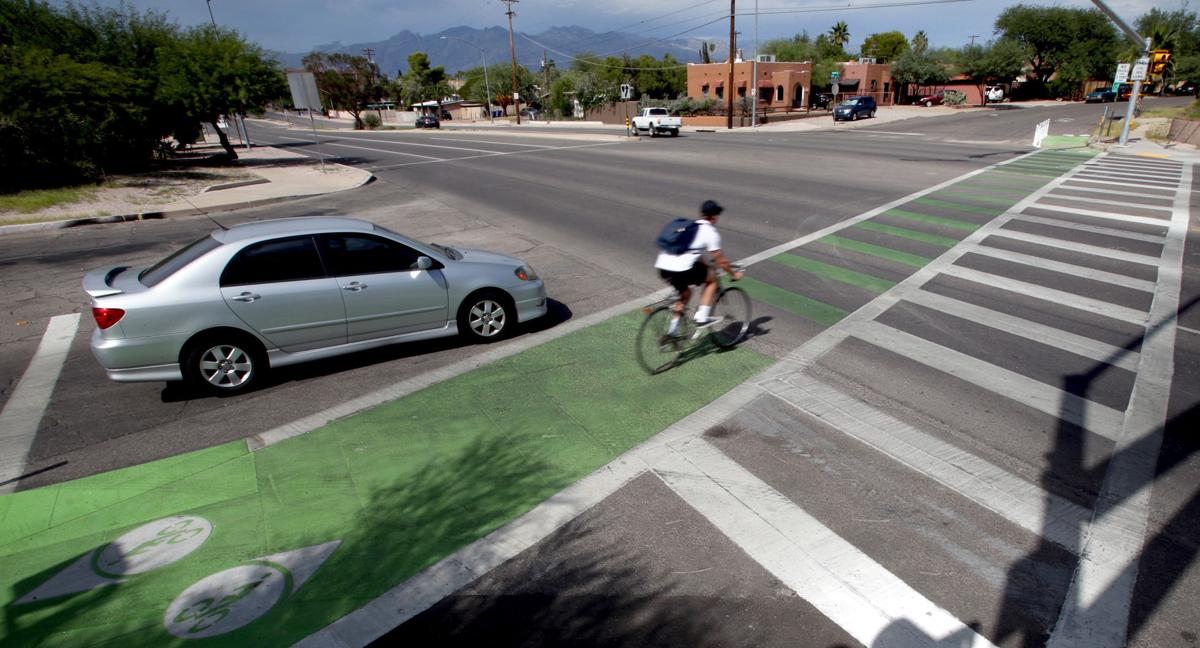At a study session last week, the Tucson City Council voted unanimously to direct its staff to develop a complete-streets policy.
Like this columnist, most readers probably have the same question: What are complete streets, anyway?
The transportation department’s Andy Bemis and Evren Sönmez of the Living Streets Alliance, which will be helping the city develop the policy, had some answers for the Road Runner.
“The title kind of says it all,” Bemis said. “Complete streets are ones that function well for people of all ages and all abilities, and whatever mode they may choose.”
“Investments with the greatest potential impact on roadway safety are prioritized before those that primarily address roadway capacity for single occupancy vehicles,” according to a memo included in the study session’s meeting materials. “Complete streets provide access to safe and affordable transportation options for people regardless of their age, ability, income, race or ethnicity, whether they are walking, biking, taking public transit, or driving.”
More than 1,200 jurisdictions have adopted complete-streets policies in the United States, according to the National Complete Streets Coalition.
As evidenced by years of high pedestrian fatalities in our area, there are parts of town that aren’t the safest place to be on foot. Or in a vehicle for that matter: Of the 62 traffic deaths in Tucson last year, 21 were people in cars. Twenty-seven were pedestrians, a jump over the prior year, according to data presented at the study session. Bemis said those figures are one of the driving forces behind the complete-streets effort.
“Too many Tucsonans are killed every year on our roadways and we simply aren’t taking this seriously enough,” said Councilwoman Regina Romero, who requested the discussion of the complete-streets policy.
But just because the city doesn’t have a complete-streets policy in place doesn’t mean “we have a policy to build incomplete streets,” Bemis said.
As a “prime example of what a complete street is,” he pointed to improvements a number of years ago on North Mountain Avenue, which include wide, buffered bike lanes and just two lanes for vehicles. Sönmez highlighted the East Fifth Street-North Euclid Avenue intersection, which has a HAWK crossing beacon and bright green markings to alert motorists to cyclists and pedestrians, and the protected bike lane running along Stone Avenue by Pima County Consolidated Justice Court as elements compatible with the complete-streets visions.
“We have bits and pieces of these complete-streets elements,” she said.
Bemis said it’s too early to say exactly how the policy — which will be developed over the next year — would impact transportation infrastructure projects, but said is it’s his hope that the priorities of RTA reauthorization or other streams of transportation funding “would be informed by this vision.”
As to the possibility of additional costs of adoption and implementation, Bemis said, “I think on the contrary that generally building better biking and walking infrastructure is far cheaper than building additional vehicle lanes.
“What my hope will be out of it is that it will be more prioritization of those modes, it wouldn’t be adding additional costs to existing projects,” he added. “It would be prioritizing different projects.”
Sönmez clarified the policy would not mean every street in the Tucson metro area being retrofitted with pedestrian-, cyclist- and transit-friendly modifications. The idea, she said, is having “a reliable network for each mode of transportation.” She said the city’s growing network of bike boulevards — low-traffic, low-speed roads with other safety features for cyclists — is a good step in that direction.
In coming months, the city, the alliance and other stakeholders — such as county government, developers, the business community, as well as motorists, cyclists and pedestrians — will develop the policy and also take community input, likely in the spring and early summer. Sönmez said the goal is to bring the final policy back to the council for approval later in the year.
DOWN THE ROAD
Starting Monday, Jan. 29, crews working for the city will begin lowering manhole and water-valve covers on Craycroft Road from East Grant Road to East 29th Street. Shifts will be from 7 a.m. to 4 p.m. Monday through Thursday, and will last through early March, when milling and repaving is expected to begin. The project is part of the Road Recovery Bond Program.





